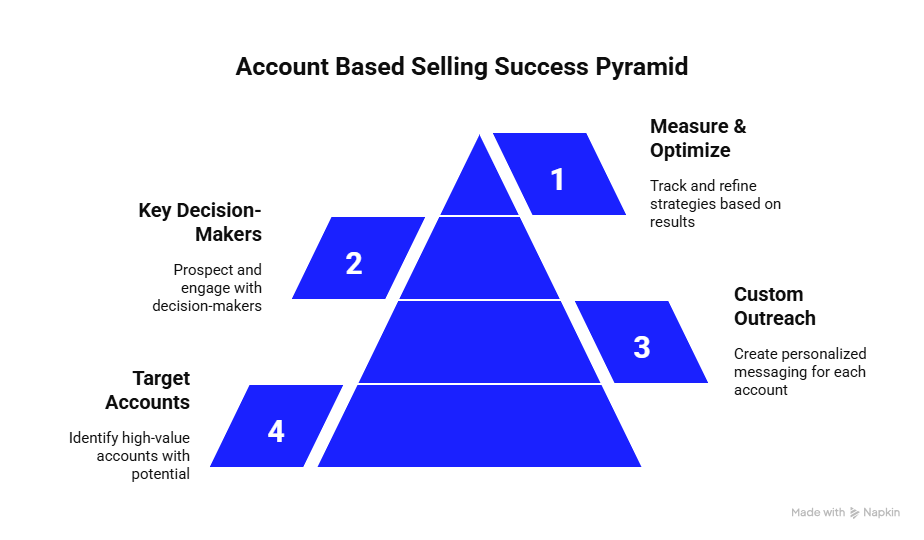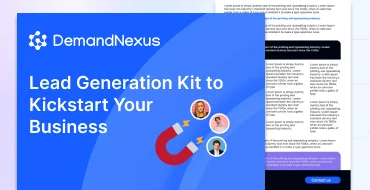Account-based selling (ABS) revolutionizes B2B sales by focusing on high-value target accounts with personalized, multi-touch strategies. Unlike traditional sales funnels that cast a wide net, ABS treats each account as a market of one, aligning sales reps, marketing teams, and tools like Salesforce to engage key stakeholders effectively. This approach shortens sales cycles, boosts conversions, and maximizes revenue through tailored content and strategic outreach. In this comprehensive guide, we explore the ABS definition, process, framework, and key metrics, with a case study highlighting how
DemandNexus drives success.
What Is Account-Based Selling (ABS)?
Account-based selling is a B2B sales strategy that targets a curated list of high-value accounts, engaging them with personalized outreach tailored to their specific needs and challenges. ABS aligns sales and
account-based marketing (ABM) efforts, leveraging data-driven insights to build relationships with multiple stakeholders within each account. Unlike traditional sales, which prioritize lead volume, ABS focuses on quality, aiming to convert, retain, and expand key accounts for long-term revenue growth.
The ABS process integrates tools like Salesforce for account management and platforms like LinkedIn for prospecting, creating a seamless flow from identification to advocacy. It’s ideal for B2B companies with complex sales cycles, where decisions involve multiple decision-makers.

ABS vs. Traditional Sales: Key Differences
ABS diverges significantly from traditional sales strategies. Here’s a comparison:
| Aspect |
Account-Based Selling |
Traditional Sales |
| Focus |
High-value target accounts |
Broad lead generation |
| Approach |
Personalized, multi-stakeholder |
Generalized outreach |
| Sales Cycle |
Shorter for high-fit accounts |
Longer, less targeted |
| Goal |
Deep relationships, high ACV |
Volume of conversions |
ABS’s targeted approach aligns with the modern B2B buyer’s demand for customized solutions, making it a powerful
selling framework.
Benefits of Account-Based Selling
ABS offers distinct advantages for B2B companies, especially those targeting enterprises or complex accounts:
- Higher Conversion Rates: Personalized outreach resonates with decision-makers, boosting conversions.
- Shorter Sales Cycles: Targeting high-fit accounts reduces cycle time by up to 30%, per industry studies.
- Increased Revenue: Larger deal sizes and upsell opportunities drive higher average contract values (ACV).
- Better Alignment: Sales and marketing collaborate closely, ensuring unified messaging.
- Improved Retention: Strong relationships foster loyalty, reducing churn.
The ABS Framework: A Visual Model
The ABS framework is a structured process that guides accounts through a tailored sales journey. Often depicted in diagrams or icons as a flipped funnel, it starts narrow (target accounts) and widens (stakeholder engagement). Here’s a visual breakdown:
- Top (Narrow): Identify and research target accounts.
- Middle (Expanding): Engage multiple stakeholders with personalized content.
- Bottom (Wide): Convert, retain, and expand accounts.
This model integrates sales and marketing strategies, leveraging tools like Salesforce for account tracking and LinkedIn for stakeholder outreach.
Steps to Implement an ABS Process
Implementing ABS requires a clear plan and cross-functional alignment. Follow these steps to build an effective
sales process:
1. Define Your Ideal Customer Profile (ICP)
Create an ICP based on firmographics (e.g., industry, revenue) and behavioral data (e.g., intent signals). Use
ICP tools to identify accounts with high revenue potential.
2. Build a Target Account List
Select accounts that align with your ICP, prioritizing those with significant cross-sell or upsell opportunities. Tools like Salesforce or
lead research services help refine this list.
3. Map Stakeholders
Identify key decision-makers and influencers within each account, such as C-suite executives or department heads. Use LinkedIn Sales Navigator to gather insights on their roles and pain points.
4. Develop Personalized Content
Craft account-specific content, such as tailored case studies, whitepapers, or
cold email sequences. For example, a SaaS company might send a CTO a report on industry-specific solutions.
5. Execute Multi-Channel Outreach
Engage stakeholders across channels like email, LinkedIn, phone calls, and webinars. Coordinate efforts using Salesforce to ensure consistent messaging and track interactions.
6. Nurture and Convert
Use personalized demos and
appointment-setting to address objections and close deals. Sales reps should leverage stakeholder insights to pitch tailored solutions.
7. Foster Long-Term Relationships
Post-sale, nurture accounts with ongoing support and content to drive upsells and referrals, maximizing customer lifetime value (CLV).
8. Measure and Optimize
Track performance using key metrics and refine strategies based on data. A/B test outreach tactics to improve engagement and conversions.
ABS and ABM: A Synergistic Approach
ABS works hand-in-hand with account-based marketing (ABM), creating a unified
sales funnel. ABM generates targeted content to warm up accounts, while ABS converts these leads through personalized sales strategies. For example, ABM might use LinkedIn ads to engage stakeholders, and ABS follows with tailored demos. This synergy, supported by tools like Salesforce, ensures a seamless customer journey from awareness to advocacy.
Key Metrics for ABS Success
Tracking the right KPIs is critical to measuring and optimizing your ABS strategy. Focus on these
metrics:
| Metric |
Formula |
Why It Matters |
| Account Engagement |
Interactions per account (clicks, views) |
Shows campaign resonance |
| Deal Velocity |
Time from opportunity to close |
Measures cycle efficiency |
| Conversion Rate |
(Closed-Won Deals / Opportunities) * 100 |
Gauges closing success |
| Average Deal Size |
Total revenue / Number of deals |
Reflects high-value wins |
| Customer Lifetime Value (CLV) |
(Revenue per account * Lifespan) – CAC |
Tracks long-term value |
Use Salesforce dashboards to visualize these KPIs and identify areas for improvement.
Case Study: DemandNexus Accelerates ABS for a SaaS Provider
A SaaS company offering CRM solutions struggled with long sales cycles and low conversion rates for enterprise accounts.
DemandNexus implemented a robust ABS strategy to transform their approach.
- Challenge: Only 10% of target accounts converted, with cycles averaging 120 days.
- Solution: DemandNexus built an ABS framework, using Salesforce to manage accounts and lead nurturing to engage stakeholders. They deployed personalized LinkedIn campaigns and tailored demos, supported by appointment-setting services.
- Results: Conversion rates rose to 30%, sales cycles shortened to 90 days, and average deal size increased by 25% in six months.
DemandNexus’s expertise in ABS, backed by data-driven tools and strategies, helps B2B companies target and convert high-value accounts efficiently.
Tools for ABS Success
Technology streamlines ABS processes and enhances personalization. Key tools include:
| Tool |
Purpose |
Example |
| CRM |
Manage accounts and track interactions |
Salesforce |
| Social Selling |
Engage stakeholders |
LinkedIn Sales Navigator |
| Sales Automation |
Streamline outreach |
Outreach |
Overcoming ABS Challenges
ABS faces hurdles like stakeholder complexity and scalability. Address them with:
- Multi-Threading: Engage multiple stakeholders to increase buy-in, as outlined in prospecting techniques.
- Automation: Use tools like sales automation to scale personalized outreach.
- Data Quality: Leverage intent data to target accounts showing buying signals.
Your ABS Playbook
Account-based selling transforms B2B sales by targeting high-value accounts with precision. Build a strategic plan that defines your ICP, personalizes content, and leverages tools like Salesforce and LinkedIn. Track KPIs to optimize performance and foster long-term relationships. With ABS, you can shorten cycles, boost conversions, and drive revenue. Ready to master ABS?
DemandNexus offers tailored solutions to streamline your sales process and target key accounts. Contact them today to elevate your B2B strategy.





